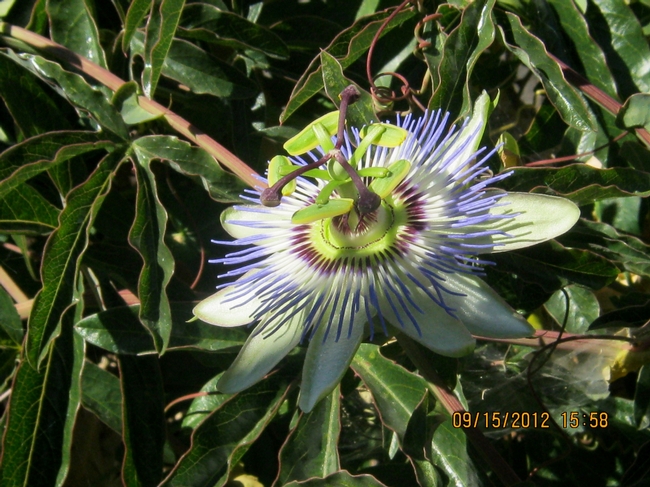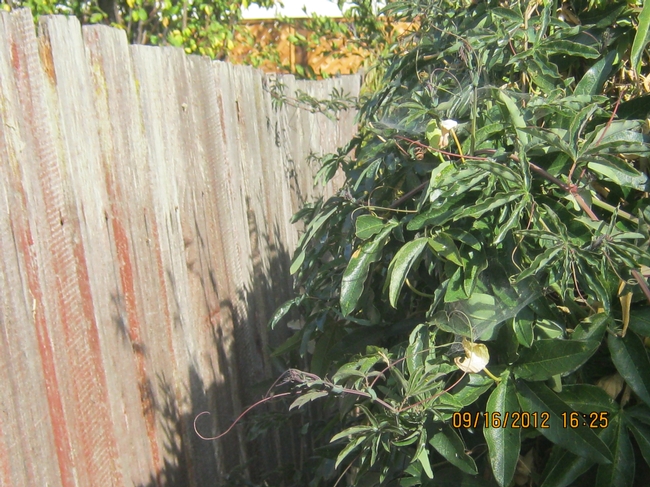Posts Tagged: tendrils
The Tale of the Thriving Passion Flower
Here's the tale. We have a thriving Passion Flower vine (Passiflora caerulea 'Blue Crown') . (http://oregonstate.edu/dept/ldplants/paca1.htm). My neighbor likes the flowers and the three butterflies that constantly flutter around it. But she doesn't like messy plants. So, last year she told her housemate to "cut back" the vine on their side of the fence because it was invading. When she wants work done, he does what she says--or there could be hell to pay. Since he doesn't know the meaning of the word "prune," that's exactly what he did---CUT. He sheered the vine on their side--like a chainsaw cutting straight down along the fence. The vine on my side simply "folded" over (like a soft flour tortilla). OMG! %#!*&@. Yeah, I was ticked off but, mostly, simply astounded.
I calmed myself and said, next time CALL ME, and I'll take care of it. I understand that the "tentacles" grow very fast and that the fruit ripen, shrivel, fall to the ground and create new shoots. Alas, I chose the wrong species and, although the orangish fruit is edible, it tastes like absolutely nothing. I try to pull it and discard it. But the purple-white-yellow flowers that turn to fruit are beautiful.
My husband said to just leave the vine "as is" for awhile--see if/how it recovers. Think about the butterflies, he said. Where will they go if the vine dries up and dies? Will we lose them forever, never again see them twitter around all day? Perhaps they'll stick around and flutter around the heap of vegetation now lying on the ground. So, let it be for now, he says.
But, that's not me. I start cutting back. Everything is intertwined (hey, it's a vine), so if you "pull" something, things break off and that's that. Well, I get to whacking, then the point of no return. I cut the whole darn thing back to pretty much three 1-inch diameter, 2-foot high stumps, so to speak. Maybe I just wanted my neighbor to understand the consequences of his actions? Maybe I thought it hopeless that the heap lying on the ground would recover? Perhaps my husband was right. But... oops, too late. In the end, I figured either it'll live or it'll die-that philosophy thrives in my yard. I did leave a couple tentacles with leaves so that maybe the butterflies would stay.
Well, the darn thing came back. Thriving. Weaving in and out and all around is the family of three butterflies, Agraulis vanillae (Gulf fritillary). Art Shapiro (butterfly expert and professor of ecology and evolution at UC Davis), says the gulf frit was first recorded in the Bay Area before 1908 and became "established" here in the 1950s and that there are fewer gulf frits in Sacramento in the last few years. Wow, I am so glad they're in my backyard. For more info, see: http://ucanr.org/blogs/bugsquad/index.cfm?tagname=gulf%20fritillaries. For photos, see http://ucanr.org/blogs/blogcore/postdetail.cfm?postnum=5850. For photos of another frequent visitor, Xylocopa varipuncta (Valley carpenter bee), see http://ucanr.org/sites/gardenweb/?blogtag=Valley%20carpenter%20bee.
Anyway... we constructed a trellis a foot from the fence, so we can monitor the vine's "tentacles" and direct them to stay on our side. Oh yeah, last month my neighbors cut back their Privet (Ligustrum spp.). It had become a very big and intrusive tree, plus it was crowding out my Snowball bush (Viburnum opulus). I told him to go ahead and trim the snowball bush and showed him where to "stop" the cuts. But, guess what? He decided not to touch the dang thing.

Orange passiflora butterfly. (photos by Susan Croissant)

Passiflora flower.

Passiflora sideview of fence.
Ahh Hoyas!
Did your Mother or Grandmother have a “wax plant” when you were young? Did you notice those twining tendrils wrapping round and round a small plastic trellis or perhaps a tall, thin slat of wood? How about the tight cluster of white or light pink flowers looking rather like other-worldly flowers – thick and waxy, looking as though made from porcelain – hence the name “wax plant. Welcome to the world of the hoya, a group of 200 or more species of the Asclopiadaceae family. These root-climbing, twining or loose shrubs are native to India, S. China, to some Pacific Islands, as well as Australia. They are evergreen with fleshy or leathery leaves. In our clime, hoyas are strictly indoor plants, although there are a few varieties that are only for those with greenhouses; this is because hoyas prefer the moist, warm atmosphere along with a little shade, and well-drained soil.
Hoyas are one of the easiest indoor plants to grow. You water them and then let the soil dry out between watering. One rule however: never cut off a flowering “spur”; the reason is that the new blooms will form on these with the “spurs” growing longer and longer with each bloom. These plants prefer to be root-bound in their pots in order to bloom, so they are not exactly for those who want instant bloom. Some of mine have been in their 8 inch pots for years and show no signs of wanting a larger pot.
I have 14 hoyas living in my home; some are in the eating area where they receive bright morning light and sun, while others are in the spare bedroom where they receive Southern light and no real sun. Still others are growing the mostly shaded area of my family room. Foliage sizes range from the mammoth leaf of the Hoya lauterbachii, with its silky, rather furry leaves measuring 6 inches long and 4 inches wide to the very delicate leaves of the Hoya shepherdi (longifolia) which has foliage 10 inches long and
¾ inch wide. My newest specimen is the Hoya odorata which has foliage 2 inches by 1 inch and when it blooms will have a loose, large cluster of white blossoms which resemble shooting stars with a rather distinct rather sweet odor. I had one years ago and gave it away and have never (to this time) had another one last any length of time. So far, I’m on a roll – had the latest one 1 month without succumbing “to the elements” as my Mother would say.
The beauty for me is looking at them weekly and seeing where the tendrils go. One of them hangs straight down for about 2 feet. It is a Hoya carnosa or Hindu rope vine which can grow to 10 feet with the twisted and crinkled leaves held close to the stem. This gives a rather thick coiled appearance to the plant, but is very light weight. This plant hasn’t bloomed yet as it’s only been in the current pot for 5 years. According to the various books I’ve read, I can expect white flowers with pink centers that will have a slight scent. I’m waiting for that, I tell you!
Most of my collection have leaves of solid dark green. However, the plant I have had the longest has leaves of light green; no amount of fertilizer has turned those leaves darker. Another hoya has grey metallic blotches on the leaves; another has dark green leaves variegated with yellowy white.
I enjoy this interesting and unusual family of plants in my home. They give me a big bang for the buck, so to speak, without being needy and can go for a while without much care. As I also have ferns in the house, this aspect is quite appealing!
The next time you receive a Logee Greenhouse catalog, check out the selection of hoyas. Another good source for hoyas and other indoor plants is Glasshouse Works in Stewart , Ohio. Lovely plants and lovely-meaning low—prices! I think you may re-think having “old fashioned” house plants. I know I did!

